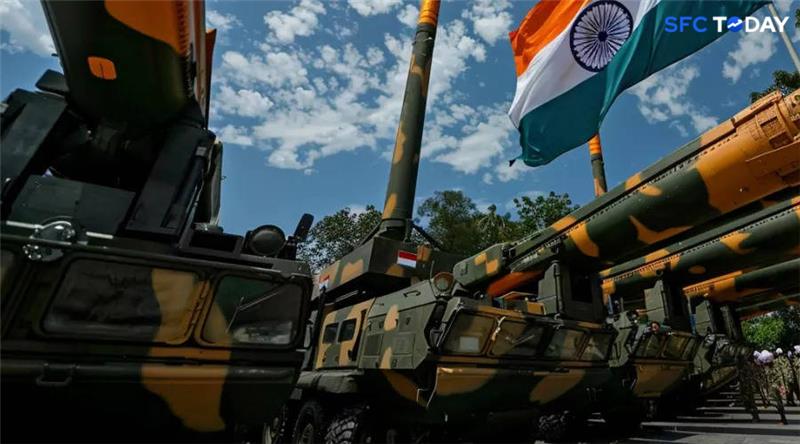From stealth warships to mega highways, the 2025 defense & infrastructure boom is reshaping the future
India is undergoing a major transformation in both its defense and infrastructure sectors. With record-high spending, bold new projects, and a strong push toward self-reliance, the country appears to be making strategic long-term investments. But this rapid growth has also raised questions about whether these developments are truly sustainable or if they carry the risk of becoming a financial and policy bubble. This article explores the latest developments, their impact, and the possible challenges ahead.
A Historic Rise in Defense Spending
India’s defense budget for the year 2025–26 has reached a record high of ₹6.81 lakh crore, which is roughly 81 billion US dollars. This is a 9.2% increase compared to last year and nearly three times the amount allocated in 2013–14. A large part of this budget is focused on buying new weapons, upgrading old systems, and boosting research and development in defense technology.
The Defense Research and Development Organisation (DRDO), India’s premier defense research body, has received a significant boost in funding. Its budget increased by over 12% this year, showing the government’s focus on building high-tech military equipment within the country.
Eyes in the Sky: The Push for Satellite Surveillance
After recent border tensions with Pakistan, India announced plans to launch 52 new military surveillance satellites. These satellites will improve the country’s ability to monitor its borders and protect its interests from space. The government is also preparing a new military space strategy to guide the use of these assets.
This move marks India’s serious entry into the military use of space technology. With better satellite coverage, Indian forces can get real-time updates about enemy movements, track threats faster, and make more informed decisions during operations.
Made in India Missile Systems and Radars
India’s military has also begun using several homegrown systems. The Akash missile system, designed for air defense, was successfully deployed during recent conflict situations and received strong praise from the armed forces. Another key development is the Surya radar system, which can detect stealth aircraft. This is especially important as neighboring countries are reportedly acquiring advanced fighter jets with stealth features.
These developments show that Indian-made technology is becoming more reliable and capable. By building such systems within the country, India is not only saving costs but also reducing its dependence on foreign suppliers.
Expanding Naval and Aerospace Strength
India’s Navy is set to receive a new stealth warship, INS Tamal, equipped with BrahMos missiles. This ship will strengthen India’s maritime power and show off the country’s ability to build complex warships. At the same time, construction of new submarines, destroyers, and frigates is taking place in Mumbai shipyards, as part of a larger plan to expand the Navy’s reach in the Indian Ocean.
On the aviation front, a major partnership between India’s Reliance Infrastructure and France’s Dassault Aviation is expected to produce Falcon 2000 jets domestically. These jets will be used for both military and civilian purposes. The project, based in Nagpur, is expected to be fully operational by 2028 and is part of India’s aim to build its own aircraft industry.
Defense Corridors and State-Level Growth
States like Uttar Pradesh, Maharashtra, and Tamil Nadu are playing a big role in India’s defense and infrastructure expansion. In Uttar Pradesh, a defense corridor has been set up where parts of missiles like BrahMos and Akash are being made. Since 2017, the state has attracted massive investment and launched thousands of projects, including a new green data center powered by renewable energy.
Maharashtra is developing a defense hub between Nashik and Pune. The area will also benefit from a new port at Vadhavan and new highways connecting key industrial zones. Meanwhile, Tamil Nadu is becoming a hotspot for drone and electronic warfare equipment production. Local companies are growing fast thanks to government support and incentive programs for manufacturing.
India’s Rise as a Global Arms Exporter
India’s defense exports have seen rapid growth. In the last financial year, defense exports rose to ₹21,000 crore, which is about 2.6 billion US dollars. This is a 32% increase from the previous year. The government is now aiming to boost exports even further by offering cheap loans through EXIM Bank to international buyers.
Indian-made equipment like Bofors howitzer ammunition and military drones from Tamil Nadu are already being sold to other countries. These exports not only bring in foreign exchange but also improve India’s reputation as a defense producer in the global market.
Infrastructure Growth: Connecting the Nation and the Military
India’s massive infrastructure projects go beyond just civilian use—they also help military readiness. Under the National Infrastructure Pipeline, over 7,400 projects have been approved, with nearly ₹2 lakh crore in investment. Construction has become a major contributor to the economy, accounting for over 13% of India’s GDP. This is expected to rise even further in the coming years.
Projects like PM Gati Shakti aim to create fast and efficient transportation networks, such as expressways and industrial corridors. These roads and railways not only support trade but also allow the military to move equipment and troops quickly in times of need. For example, the Bengaluru–Chennai corridor helps both businesses and defense forces with faster connectivity.
A Strategic Bet with Global Ambitions
Supporters of India’s defense and infrastructure boom believe that these developments are part of a long-term plan to become a global power. The country is investing in modern weapons, space technology, and export-oriented manufacturing. All of this is backed by a growing economy and a strong political push toward self-reliance under the “Make in India” program.
The focus on indigenous systems, from missiles to warships, is already showing results. India is not only protecting its own borders more effectively but also building a reputation as a regional security provider. The combination of defense production and large-scale infrastructure is also creating jobs and supporting local industries.
The Bubble Risk: Overheating and Execution Challenges
Despite all the positive signs, there are concerns that this boom could lead to overinvestment or poor outcomes if not managed carefully. While defense budgets are rising, there are still delays in some procurement processes. India has allowed full foreign investment in defense, but actual private investments from abroad remain limited.
Many projects face challenges in land acquisition, environmental approvals, and financial management. Infrastructure megaprojects often run into cost overruns or delays, which can reduce their effectiveness. If technology upgrades or manufacturing plans fail to keep up with expectations, it could lead to wasted resources.
Another worry is that India may rely too much on partnerships with foreign companies, especially in aerospace. Any shift in global politics or trade tensions could impact supplies or disrupt ongoing projects.
A Defining Decade Ahead
India’s defense and infrastructure boom in 2025 represents one of the most ambitious efforts in the country’s history. With a strong push toward self-reliance, advanced technology, and global exports, the country is aiming to reshape its future. The direction appears strategic, bold, and rooted in long-term planning.
However, whether this becomes a lasting success or leads to short-term bubbles depends on how efficiently policies are implemented. Ensuring accountability, reducing red tape, encouraging innovation, and managing finances carefully will be key to turning this boom into a real transformation.
With the right balance of ambition and caution, India could emerge not only as a military power but also as a leader in global defense manufacturing and infrastructure development.


